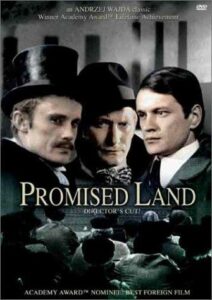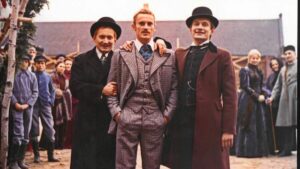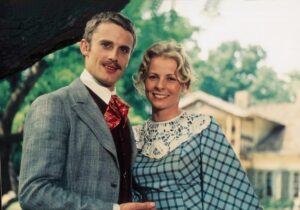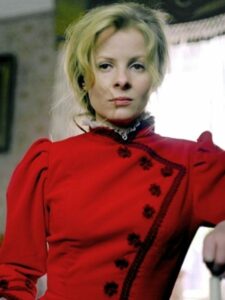Andrzej Wajda’s “The Promised Land” – Paradise for the Chosen Few

Title: “The Promised Land” (“Ziemia obiecana”)
Release Date: 1974
Director: Andrzej Wajda
Cast: Daniel Olbrychski, Wojciech Pszoniak, Andrzej Seweryn, Anna Nehrebecka, Kalina Jędrusik, Bożena Dykiel, Andrzej Szalawski, Franciszek Pieczka, Andrzej Łapicki, Piotr Fronczewski
Andrzej Wajda’s “The Promised Land” was hailed by “Film” in 1996 as the best work in the history of Polish cinema. This cinematic fresco, realized with epic panache, is a picture of the vanishing world of a noble manor and emerging capitalism. It is a portrait of a great metropolis rising on the ruins of human dreams, sweat and blood. It’s a story about Polishness entangled in difficult relations with other nations, which Hollywood denied an Oscar, accusing Wajda of anti-Semitism. It’s also an ironic story about religious and national values that become a convenient cover for a down-to-earth lust for possessions.
“The Promised Land”, or a German Pole and a Jew in industrial Lodz
“The Promised Land” – by no means the best novel by Wladyslaw Reymont – was immortalized by Andrzej Wajda’s great 1974 work. The thoroughly realistic panorama of the developing city of Lodz during the industrial revolution of 1899 fit well into contemporary contexts, both political and social. The director has placed the theme of male friendship in the foreground, which acts as a framework that unifies the various plots, but also fits in with the modern style of reception. In the world cinema of the early 1970s, films showing the fate of friends were an extremely handy vehicle for housing a portrait of an entire generation and its most salient problems.
“The Promised Land” depicts the fate of three men: a Pole, a German and a Jew, who decide to make big money together by building a textile factory in Lodz. They are: Karol Borowiecki (Daniel Olbrychski) – a gifted engineer of noble descent, Maks Baum (Andrzej Seweryn) – the son of a small German entrepreneur and Moryc Welt (Wojciech Pszoniak) – a Jewish business broker. Karol, who has a beautiful and noble fiancée Anka (Anna Nehrebecka) in his family estate Kurów, at the same time romances the alluring wife of a Jewish tycoon – Lucy Zucker (Kalina Jędrusik). When he learns from his mistress that the duty on cotton will soon increase throughout the Russian Empire, he prompts his friends to act energetically. Thanks to the shrewd Moryc’s contacts in the circle of Jewish bankers, the men raise money, with which they acquire a large amount of the commodity in Hamburg, then sell it for a large profit and build the factory of their dreams.

The news of the Polish man’s capital making spreads quickly and arouses great resentment among factory owners of other nations, as they fear that Borowiecki can count on a large market among his compatriots. At the plant’s grand opening at Karol’s house, Lucy’s husband shows up with the news that his young wife has become pregnant despite his infertility, so he suspects that Borowiecki is the father of the child. The Pole, however, allays Zucker’s fears by swearing on a picture of the Virgin Mary that this is not true.
Soon the Jewish factory owner sends his pregnant wife to Berlin, and she persuades Karol to accompany her on the trip. However, at the train station, Zucker spots Borowiecki and decides to take revenge – he sets fire to the factory of Karol’s company. When the protagonist finds the ruins upon his return, he breaks off his engagement to Anka and decides to accept the offer of the wealthy German millionaire Muller (Franciszek Pieczka) – he marries his not very smart and handsome daughter Mada (Bożena Dykiel). Seven years later, a revolutionary workers’ strike breaks out at the plant. Borowiecki makes the decision to shoot at the fiber workers.
“The Promised Land” – dark metropolis versus idyllic countryside
Wajda’s “The Promised Land” was conceived as a juxtaposition of telling contrasts, visible at all levels of the film: space-time composition, music, characters and ideas. At the forefront is the significant juxtaposition of the dark face of the city and the arcadian rural landscape, which, however, goes far beyond the traditional opposition of culture and nature. Lodz, portrayed in the film in an almost documentary-like manner (Wajda used original 19th century factories, palaces and tenements), is a labyrinthine space of brick, with almost no visible sky horizon, shown in deep colors of black and red.

What is more, the temporal dimension of the city’s existence is fused with this image – it’s an area of movement and machinery – the hallmarks of the “age of steam and electricity,” and therefore of progress and modernity. This industrial landscape of Lodz harmonizes with the disturbing music of Wojciech Kilar, who introduced original industrial sounds of factories and sirens in the parts set in the metropolis. This musical theme primarily accompanies shots of the great masses of people – the downtrodden and exploited poor of the tycoons. In the interiors of the city’s palaces, where wealthy factory owners and bankers live and do their business, on the other hand, there is another – equally disturbing musical theme, based on the sounds of a solemn battle march accompanied by trumpets. It emphasizes glamour and wealth, and at the same time their destructive effect on human morality.
On the other hand, Kurów – Borowiecki’s family estate – appears completely different. It’s an idyllic, bright landscape – full of blue and green, which Kilar paints musically with the motif of the famous waltz that later accompanies the scenes of Anka’s appearance. Here we are dealing with another time dimension: the idealized Kurów turns into Arcadia – an unreal place, existing only on the level of myth. It is a kind of timelessness saturated with the richness of the landed tradition, in which nothing changes, in contrast to the dynamic Łódź.
“The Promised Land” – noble tradition versus capitalism
The juxtaposition of a predatory metropolis and a rural paradise is also a contrast of two visions of the world. On the one hand, we have the landed gentry and all the baggage of values they represent, and on the other, the emerging order of capital. The nobleman’s mansion native to Mickiewicz’s Soplicowo is a symbol of national tradition and civic duty. This is most emphatically emphasized by the figure of Father Charles, the depositary of the memory of the past, who is completely unable to find himself on the city pavement. His small living room filled with a gallery of historical portraits against the backdrop of industrial Lodz gives the impression of an open-air museum, and he himself looks like a relic of the irretrievably past. Also significant is the conflict between father and son, illustrating the process of social transformation – the gradual declassification of the landed gentry, but also the emergence of a completely new personal model: an able, educated capitalist whose success is measured by the wealth of his wallet.

It should be emphasized that the Arcadian vision of the noble manor, while tempting, is not valued unequivocally positively. This is because it is an area of compelling stagnation from which Borowiecki wants to free himself at all costs and does so, against all sanctity. His admirable energy and enterprising spirit, though reminiscent of Kmicic’s fantasy (Olbrychski consciously plays up these traits of his character with bravado), nevertheless fail to achieve the intended effect.
The hero falls into the snare of blinding mammon, destroying everything he has grown from. In this sense, he is contrasted with Trawinski (Andrzej Łapicki) – a Polish entrepreneur who commits suicide after going bankrupt, and even more so with Horn (Piotr Fronczewski). The latter, like Karol, an able Buchholz employee, is able to maintain personal dignity. He helps an acquaintance of the widow, whom Borowiecki passes by with complete indifference and demands humane treatment for his employees. So there is some third way on the horizon that Borowiecki is unwilling or unable to see. In turn, it resonates most strongly in the last scene of the movie, to which we will return.
“The Promised Land” – Wajda’s accusations of anti-Semitism
Nevertheless, whatever one may think about the character of Karol, an important dimension of his character is given by his Polish nationality, which clearly stands out against the background of foreign capital. The image of Jewish financiers, completely hermetic and limiting the possibilities of the Polish entrepreneur, is extremely acute here. When “The Promised Land” was shown in Hollywood, a cannon of accusations of anti-Semitism was immediately brought against Wajda. This was the reason why this great film lost its chance for the Oscar for which it was rightly nominated. The film’s portrayal of Lucy Zucker – as a ruthless, lustful and profit-obsessed Jewess – was considered particularly blatant.
The issue of the alleged anti-Semitism of “The Promised Land” has already been discussed many times by Polish cinema experts, who pointed out primarily that the director based the film’s script on Reymont’s novel. Moreover, Wajda greatly softened the Polish Nobel Prize winner’s critical attitude toward Jews. This is especially evident in the portrayal of Moryc – in the novel he is a much more repulsive character, constantly betraying Karol. Meanwhile, in Wajda’s movie he remains Borowiecki’s friend almost to the end, fascinated by his charisma, which he tries to emulate. There are also many indications that the film highlights class differences more than national differences. Nevertheless, leaving aside Reymont’s anti-Semitism (characteristic, by the way, of the whole of Europe at the time), one should also take into account the specific historical context, which the tragic events of the later Holocaust do not invalidate after all.

“The Promised Land” – all the loves of Borowiecki
A separate study could certainly be devoted to the female portrayals in “The Promised Land”. Three completely different heroines, brilliantly played by great actresses, still impress on the screen with their artistic mastery. Phenomenal and delicate Anka, played by Nehrebecka, is a symbol of a sentimental maiden from a noble manor, who, however, undergoes a significant metamorphosis and turns into a brave, self-aware intelligent woman. This metamorphosis is underscored by a change in style of dress – from the angelic blue and sleek hairstyle in Kurow to the red of her dress and her hair in disarray in the scene when she gives Charles the ring. Anka from the finale of “The Promised Land” is almost a modern emancipated woman who is unlikely to despair after being wickedly abandoned by her faithful fiancé. In her bold gestures, her gaze, her tone of voice, one can sense that she has perceived a world beyond the sphere of dependence on a man.
Lucy Zuckerova, phenomenally played by Kalina Jędrusik, on the other hand, is the quintessence of unbridled eroticism. This vision of female insatiability echoes the myth of an oriental beauty capable of offering a man unknown pleasure. Lucy’s sensuality seems to express itself in her every activity, coming to a head in her unbridled lust for diamond jewelry, under which her neck and ears almost bend, and her appetite for tasty foods. These traits are especially multiplied when the woman becomes pregnant, as highlighted by the famous scene on the train.
Mada in the version of Bożena Dykiel, on the other hand, is the embodiment of a not very smart, but clean and obedient German bourgeois. Her portrayal carries clear comic accents. The heroine’s manner of speech, defiling the rules of the Polish language, her calf-like smile and her clumsy but pushy attempts at courting Borowiecki seem to discredit her almost immediately in the eyes of the viewer. It is significant that she is the one Karol chooses as his life partner, which says a lot about his masculinity. The charismatic Borowiecki gives up the culture represented by Anka and the sensual pleasure of Lucy – both are too problematic for him and have their own demands. He finds himself best in a relationship with a woman without a shadow of intelligence and erotic allure, playing the role of his submissive slave.
“The Promised Land” – God and homeland as slogans hiding the lust for money
Most important for the overall interpretation of Andrzej Wajda’s “The Promised Land” is the compositional buckle in which the key ideas resound. The director’s version of the film begins with a telling juxtaposition of scenes of morning prayer by Poles, Jews and Germans, which is interrupted by stills showing a huge crowd of people making their way to the factories. The restlessness of these shots, emphasized by the musical layer, immediately introduces the viewer to the underlying issues. Here we have a multinational milieu of wealthy tycoons raising their prayers to God – clearly privileged also by the camera, which shows them individually, as opposed to the collective appearing as an impersonal mob. The same elite ruling the city appears in the film’s final scene – also pitted against the workers, whom it orders to shoot.

The beginning and the finale of “The Promised Land” clearly correspond and explain each other. It becomes clear that the fervent prayer raised in several languages is not even so much an empty ritual as a diabolical worship of the golden calf. Those who invoke God have their hands stained with blood, which is already anticipated by the drastic scene in Buchholz’s factory, when one of the textile workers dies in the cogs of the machine, staining the white cloth with blood. The red that dominates the city’s imagery becomes an eloquent symbol of the lust for money, but also of crime.
Nevertheless, it is not only religion that functions in the film as camouflage for foul deeds. The second important element masking the vile motivations of financiers is the national interest. This aspect is introduced by the shot of a proud Karol bringing his descendant clad in a nobleman’s kontusz into the palace room. For Borowiecki, who has rejected the entire legacy of the past and traditions, suddenly nobility and the Polishness it symbolizes turn out to be a convenient ornament to camouflage the simpering lust for mammon. One can see here the usurpation of values and ideals that the hero consciously and cynically rejected. Significantly, however, they were found on the opposite side – in the attitude of the rebellious workers led to the barricades during the 1905 revolution by a social formation quite different from the capitalists – the intelligentsia. It was they who, unlike in the rest of Europe, became the heirs to the heritage of noble culture and the leading force of the Polish nation.
“The Promised Land”?
In Wladyslaw Reymont’s novel, the title “The Promised Land” has an ironic dimension; in Wajda’s case, not quite. This was largely due to the temperament of the director inclined more to tragic tones, but also to the contemporary context in which the movie was read. Namely, viewers saw in it an analogy to the Gierek era, when Poland turned into a huge construction site and implemented accelerated industrialization with money from Western capital. In this sense, Reymont’s adaptation was a warning against the degeneration accompanying this process. Another, perhaps more important context, however, was the tragic events on the Coast in December 1970, to which the telling (added by Wajda) final scene of bloodshed referred.
The biblical metaphor into which Reymont inscribed his novel also resonates in the movie. Industrial Lodz – the hope of workers flocking from everywhere hoping to make a living – turns out to be the “promised land” only for a select few, while for others it becomes its caricature. This is eloquently conveyed in Trawinski’s succinct dialogue with his Jewish friend David Halpern, fascinated by the city’s development:
“- Łódź is for the wise.
– When will it be for the honest?
– Sha, Mr. Travinsky, they have heaven.”
Literature:
A. Garbicz, Kino, wehikuł magiczny. Przewodnik osiągnięć filmu fabularnego. Podróż piąta 1974 – 1981, Kraków 2009.
T. Lubelski, Historia kina polskiego 1895 – 2014, Kraków 2015.
B. Kwieciński, Ziemia obiecana Wajdy według Reymonta: film o niespełnionych obietnicach, [w:] Od Mickiewicza do Masłowskiej. Adaptacje filmowe literatury polskiej, pod red. T. Lubelskiego, Kraków 2014
